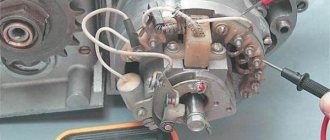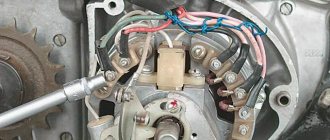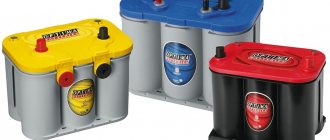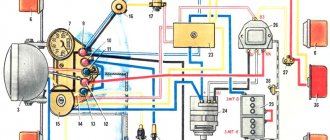Gel batteries are already quite widespread in household appliances today. Most often they can be found in uninterruptible power supplies (UPS), scooters, radios, and various portable devices. This type of battery lasts 3–4 years, and then problems begin with their operation due to severe loss of capacity. Gel batteries remain in charge-standby mode for a long time and for this reason their nominal capacity decreases. Another problem is boiling away of water from the electrolyte. Although they do not contain liquid electrolyte, the fiberglass on the lead plates must be kept moist. Gel batteries are mostly maintenance-free, but getting to the banks is realistic and not so difficult. Therefore, if problems begin with the battery, you can try to restore it.
In what cases is battery restoration inappropriate?
It should be noted right away that in most cases, failed gel batteries cannot be restored (swelling, destruction of plates, etc.). In such a situation, you shouldn’t bother with them and it’s easier to buy a new one.
Signs that a gel battery cannot be restored:
- Bloating. Swelling of one or more jars indicates that the electrolyte gel has peeled off from the lead plates. This battery can no longer be restored and is heading straight to the landfill. Bloating can be determined visually;
- Destruction of plates. This often happens as a result of long-term operation of uninterruptible power supplies in a poorly ventilated place. As a result of prolonged exposure to elevated temperatures, the contents of the jars are destroyed, including the fiberglass, gel electrolyte and the plates themselves. In particularly advanced situations, only coal dust remains inside. To identify this problem, shake the gel battery and listen. If something is loose inside, then the battery belongs in a landfill. There is no use in restoring it. You can also shine a light and look inside the openings of the cans. If the plates are visually indistinguishable, then the battery has served its purpose.
In the photo below you can see gel batteries that cannot be restored:
Swollen batteries
Batteries that cannot be restored
Gel battery with destroyed plates
If the insides of the battery are not destroyed, but the gel layer dries out and the capacity is lost, then there is a chance to restore the battery.
general description
Currently, gel batteries are widely distributed in various retail outlets, where they offer a wide range of spare parts for various vehicles.
However, many people still do not know what the device is, how it works and what benefits it has. The fact is that externally the battery is not much different from its close cousins that run on acid. For many years, old wet batteries have been in great demand. We are talking about acid models. However, as modern batteries developed, humanity began to actively abandon old, not entirely environmentally friendly systems, giving preference to improved modern developments.
Initially, such devices were developed exclusively for military transport, including aviation, where conventional batteries could not perform their task because they constantly overheated and lost capacity. As a result, they quickly failed and were no longer suitable for further use. Soon new inventions appeared on the market - gel analogues , which quickly occupied a leadership niche and began to gain popularity.
How to restore a battery
Now directly about how to restore a gel battery. The gallery below shows the procedure. First, remove the top plastic cover. Then the rubber caps are removed from all cans.
Remove the plastic cover
Remove the rubber caps
The battery is ready to be filled with water
There are also varieties of gel batteries with individual caps over each can. You will have to remove them all and then remove the rubber caps.
Removing plastic covers
Removing caps
The battery is ready for restoration
After this, using a regular medical syringe, add 2 “cubes” of distilled water to each of the jars. It is better to purchase it at a pharmacy, since car dealerships often sell just tap water.
Do not add a lot of distilled water. Moreover, the plates should not float in it. Water is required to return the gel electrolyte to its normal state and restore the battery. During operation, distilled water evaporates and as a result the gel dries out. It is better to pour a little water into 1-2 “cubes” and leave the battery for 2-3 hours.
The water will gradually be absorbed. Then add more if needed. It is enough just to keep the fiberglass with the gel moisturized. But nothing should float in the water. If there is water bubbling around in the jar, it needs to be pumped out with the same syringe.
The easiest way to measure distilled water is to measure it and fill it with a syringe
. After the water is absorbed, a reaction will take place and the gel battery will come to life.
You may even notice an increase in voltage. After this, you need to install the rubber caps in place and secure the lid. It needs to be secured either with tape or glued on. This is important because the rubber caps act as a valve, releasing the gas released during operation. And the lid acts as a retainer so that the caps do not fall off. Further recovery involves normal battery charging. Do not forget that the voltage should not exceed 14.4–14.6 volts, and the current is 0.1 of the battery capacity. If the battery is from a UPS, you can install it back and charge it in the case. To do this, simply connect it to the network and turn it on without load.
It may happen that during the charging process the battery will accept current very poorly. If charging has been going on for several hours and the current is not perceived, you need to increase the voltage to 20 volts.
Attention! In this case, you will need to constantly monitor the charging process until the current flows. This will be visible by the voltage drop. It is important not to miss this moment, otherwise the gel battery will be damaged. I will say more, exceeding the current several times the permissible will cause smoke and burnout of the gel battery.
After the battery begins to accept current, set the voltage to about 14 volts. In this case, the current should not exceed 0.1 of the battery capacity. Then charge as usual and the battery will be restored.
The first is pouring distilled water into the battery jars
Although gel batteries are also called dry batteries, they must contain a water-based electrolyte inside them. And water in gel, and especially in acid, batteries is a consumable material, since when it is reduced by electrolysis of lead sulfate deposits on the plates, it is destroyed into the hydroxyl group and hydrogen. The latter leaves any battery into the surrounding air. In gel batteries, hydrogen escapes through rubber valve caps located under the outer plastic cover, which is often covered. Therefore, a very dry gel battery that has lost capacity needs to be topped up with distilled water .
To service a “maintenance-free” battery, you will need to tear off the glued top cover and remove all valve caps. You need to add a little water - not to the edges of the filler necks on the jars. The poured water will be absorbed into the filter paper, so after half an hour, look (by shining a flashlight) to see how much water is left in each section of the battery. The water level should slightly cover the surface of the battery plates, so excess liquid will have to be removed with a syringe or rubber bulb.
If the battery has lost a lot of capacity
In this case, you need to carry out cyclic charging to “heat up” the battery.
The battery is charged as much as possible and then discharged. To do this, you can use a low-wattage car light bulb. This way you can complete 3-5 cycles. Make sure that during the discharge process the voltage does not drop below 10.5 Volts. There are particularly severe cases when a gel battery does not restore capacity after cyclic charging. Then, with a high degree of probability, it can be argued that part of the lead plates fell off from the output of the can (cans). It is impossible to restore such a battery. Here all that remains is to operate it with a smaller capacity or buy a new one.
Advantages of gel batteries
As is known, in classical electrical power sources, the electrolyte reaction occurs very intensely and quickly, which is accompanied by the release of vapors.
By the way, at high overloads, boiling of the electrolyte and even explosion of the device cannot be ruled out. Will the new gel device be subject to such troubles? Fortunately, no: it works on a different principle and has many advantages over classic devices. This device uses an electrolyte with a special viscosity that has a jelly-like consistency. By adding a thickener to the battery, you can continue to use it freely in any conditions. But the effectiveness of the system in a position on its side is sharply reduced, and turning it over is generally prohibited. However, gel-type models have undeniable advantages, which include:
- Possibility of repeated charge-discharge cycle.
- No need for initial charging after purchase.
- Preservation of capacitive characteristics during discharge to zero level.
- Maximum starting current.
- Minimal loss of capacity during long periods of inactivity. For comparison, acid models quickly lose their working life if they are not used for their intended purpose.
- Extended service life.
We recommend: How a gel battery works, its advantages and disadvantages
Partial or complete damage to the body of such a battery will not affect its performance in any way, so there will simply be no need to carry out complex repairs. By comparison, when using lead models, a problem such as electrolyte leakage often occurs. In gel ones, the latter is not in a liquid state, so any leakage is completely excluded.
Modern analogs are not only high-tech, but also the safest. Their service life can reach 10 years, although this most likely applies to the most expensive models.
Procedure
First, you need to charge the battery to 14.4 V. By connecting a halogen light bulb or other load, the power source is discharged to 10.6 V. This is repeated three times, and then the battery is fully charged. To check the energy capacity, use a load fork or do it with a car starter. If it was possible to restore the capacity, good; if not, resuscitation continues.
In 90% of cases, reversing the polarity will help restore the battery. The procedure consists of three stages:
The process of reversing the battery polarity.
- A load in the form of a halogen lamp is applied to the battery to discharge it to 0. Depending on the residual energy capacity, it may take about a day until the lamp goes out. The lamp is not turned off for another 2–3 days so that the “remains go away.”
- Charge the battery with reverse current. To do this, you need to connect the charger in reverse, that is, “plus” to “minus”, and “minus” to “plus”. To prevent anything from happening to the charger (or the short circuit protection does not work), a halogen lamp is connected in series. Next, it remains to charge the battery in reverse polarity. When the voltage reaches 5 - 6 V, the lamp can be removed from the circuit. As for the charge current, it is recommended to set it to 5% of the energy capacity. Let’s say the battery capacity is 60 Ah, which means the charging current should be 3 A. During charging, the electrolyte will begin to “boil” - this is normal, since the process goes in the opposite direction. Charging may take about a day - during this time the voltage will rise to 12 - 14 V. As a result, the battery will be charged, and the output of its “plus” will be “minus”, and the “minus” will be “plus”.
- Reconnect the halogen lamp and discharge the battery for a couple of days. Next, carry out the correct charging, taking into account the polarity, until the voltage reaches 14.4 V.
This is the method of restoration using the polarity reversal method.
When can you restore your battery?
When everything is visually (no swelling, no mechanical damage to the case) and the insides are in order, the plates are in place, but the gel layer has simply dried out and a loss of energy capacity has occurred (a parameter measured in Ah) - they try to restore it.
But first, check with a voltmeter and a load plug:
Checking the battery with a voltmeter or load plug.
- Set the voltage at the terminals.
- Connect the load.
- 3 – 4 seconds simulate the operation of the starter.
- See how quickly the voltage is restored.
If the current drops rapidly, then the battery is reaching its end. Another moment will tell you the same thing – when it charges quickly.
Posts 8
1 Topic by Jonni 2010-04-10 20:18:30
- Jonni
- Heavenly slug
- Inactive
- From: Russia
- Registered: 2009-02-25
- Messages: 12,039
- Reputation: [210 | 4 ]
Topic: How to reanimate a acid scooter battery?
After winter hibernation, two-wheeled friends have battery problems. Often the owners themselves are to blame for the death of the battery, because... Everyone knows that in the winter the battery needs to be removed, fully charged, preferably stored in a warm room and checked the charge level once a month and recharged if necessary. I had a problem with my scooter in the first winter. I did everything right, removed it, but in the middle of winter the charge dropped and I decided to recharge it with a car charger, put it on charge and since then the battery has died. It refused to hold a charge, but of course the scooter started up and drove, all the lights worked, during a long trip the battery was recharged, but after half an hour of parking it died again. Why did this happen? When charging, any battery should be charged with a current of no more than 10% of its capacity, i.e. the standard capacity of a car battery is 55 A/h, it turns out that when charging the battery, a car charger produces 5.5 Amperes, and the capacity of a scooter battery is 4 A/h, which means it needs to be charged no more than 0.4 Amperes, so It turned out that the car charger ruined my scooter battery. I dug around in the Internet, found some information on restoring the battery, and decided to get confused. Here's what I did:
I took a dead battery (by the way, it’s an acid battery), opened all the caps, poured out the acid, poured distilled water into it, chatted (just not too much), poured it out and so on several times, then took it and poured the acid in (at the level in each jar). Next, I needed to charge the battery, but all my attempts to find the kind of charger I needed were unsuccessful. I found on the Internet that you can take a 12-volt power supply from an old player, it just produces about 0.5 Amperes. Luck smiled at me, I found such a power supply that I had left since the time of default
Using a tester, I figured out which wire was “plus” and which was “minus” and made fastenings to the terminals.
We put the battery on charge and leave it to charge for at least 10-12 hours
You can periodically check the charge with a tester
After charging, we connect some powerful power source to the battery, I used a car low beam lamp, and completely discharge the battery (the first three cycles, my battery was discharged in 10-15 minutes, then longer and longer) and so we spend about 10-15 -three cycles of full charging and full discharging (but under no circumstances leave the battery in a completely discharged state for a long time). After this procedure, my battery came back to life and holds a charge for about a month, so it’s already been four years. For me this was relevant because... The scooter has an anti-theft alarm; with the battery not working, it was unsettling to leave the scooter on the street for a long time. Well, it seems like I told you everything, probably this method can be applied to a car battery, but there it is. I found all the information on this method of restoring a scooter battery on the Internet.
ps: the maintenance-free (according to the seller, silicone) battery could not be restored in this way.
Source
Principle of operation
Before you begin restoring gel batteries, you need to understand in detail the principle of their operation and the main differences from other types of batteries. In essence, it is somewhat similar to that used in sealed acid-type devices. However, experts mention two main differences.
A special gel-like substance is used as an electrolyte, which consists of purified water and sulfuric acid, which influenced the appearance of the characteristic name. Many car owners attribute the name “helium” to the systems, although this is not entirely correct, since they do not operate on gas.
Overcharging of such devices is unacceptable, because it causes a rapid loss of capacity. To avoid such consequences, it is advisable to maintain a voltage range of 14-16 V.
Reanimation of a serviceable scooter battery
#1 Reanimation of a serviceable scooter battery
Post by Sylver » 15 Apr 2015, 09:36
Shamelessly torn: Dmitry. Website sammoto.boom.ru
Perhaps you have heard more than once that batteries cannot be restored? Complete nonsense and nonsense! This means that hands don’t grow there! I personally restored several dead batteries, and they worked for several more seasons! Don't give money to greedy sellers at car flea markets, don't buy Chinese crap - it may last less than your old brand battery if reconditioned correctly! So, let's begin. We have a dead or almost dead battery on our hands. We will need some materials and tools:
1) Fresh electrolyte (nominal + preferably increased density) 2) Distilled water. 3) Electrolyte density meter (hydrometer). Small. On a large one, you do not pump electrolyte from the entire battery. 4) A charger capable of providing low (0.05-0.4A) charging currents. I used the simplest homemade device - a power supply from a tape recorder, a tester as an ampere and voltmeter, plus a block of powerful resistors to regulate the charging current. 5) Desulfating additive to the electrolyte. I used the Russian additive “Dream”, produced by “NTK KULON”, St. Petersburg, conversion). 6) A small enema (sorry, I need it!) and a pipette for pouring purposes.
First, let's define possible malfunctions:
1) Sulfation of the plates - the battery capacity drops almost to zero. 2) Destruction of carbon plates - when charging, the electrolyte turns black. 3) Short circuit of the plates - the electrolyte in one of the sections of the battery boils away, the section heats up. (A difficult case, but sometimes not hopeless) 4) A frozen battery - swollen sides, the electrolyte immediately boils when charging (numerous short circuits of the plates) - nothing can be done to help here, amen, God rest his soul!
Let's start from the end of the list. (item 3) When shorting the plates, under no circumstances try to charge it! We begin rinsing with distilled water. Don’t be afraid to turn over and shake the battery, it won’t get any worse. Rinse it until the coal crumbs stop washing out (I hope this moment comes, otherwise stop this masochism). When washing, the shorting of the plates is often eliminated, and we move from point (3) to point (2). After washing and shaking out any debris from the bowels of the battery, we proceed to point (1), namely, eliminating salt deposits on the battery plates. Follow the additive instructions. My experience may differ from what you read in the instructions. Next I do this:
Fundamental differences between gel batteries
The operating principle of gel batteries is similar to that used in sealed acid batteries. Although manufacturers distinguish 2 differences.
The electrolyte is presented in the form of a gel consisting of distilled water and sulfuric acid. That's why the battery got its name. Some motorists call batteries helium. This is incorrect because gas is not used to refuel them.
Overcharging a gel battery, which leads to rapid loss of capacity, is also unacceptable. It is better to maintain the charging voltage at 14–16 V.
Among the positive qualities are:
- There is no need to deep charge the battery. After all, the rate of charge recovery does not affect the condition of the electrode plates.
- Minimal energy loss (no more than 20%) at rest.
- The number of charge-discharge cycles has been increased. Therefore, more active exploitation is allowed.
Features of lead-acid batteries
This variety has been used for a long time and is time-tested. Even today, the lead battery, whether for a flashlight or a car, is receiving improvements and modernization. Here are his positive qualities:
- low level of self-discharge;
- undemanding to maintenance;
- no memory effect;
- if necessary, produces greater current output;
- affordable because it is easy to manufacture.
But it was not without its drawbacks:
- cannot be stored unloaded;
- sensitive to negative temperatures;
- small capacity (relative to weight);
- does not tolerate deep discharge well;
- environmentally hazardous (lead compounds).
A lead-acid battery consists of the following main elements:
Battery device.
- electrodes: lead grids with lead dioxide in cells;
- separation plates that do not react chemically with acid;
- electrolyte where the grids are immersed;
- housings.
In the 1970s, a new technology for producing lead batteries appeared - AGM (Absorbent Glass Mat). In the power source, instead of the usual liquid electrolyte, it is absorbed. Such batteries: are sealed, do not require maintenance, serve for a long time if properly charged, tolerate cold well, charge 2-3 times faster and have a self-discharge even lower than in classic batteries.
Existing disadvantages
But despite the many advantages, gel batteries also have disadvantages. These include:
- Increased sensitivity to charge voltage.
- Gel models do not cope well with short circuits in the electrical circuit.
- Increased cost.
Although the devices can easily withstand severe frost and many mechanical impacts, they need to be properly charged. We are talking about the use of specially designed chargers. Otherwise, the battery may quickly fail and become unsuitable for further use. Before you decide to buy a gel battery, you need to consider these disadvantages.
conclusions
Restoring a gel battery is a simple procedure, but requires initial preparation. It should also be taken into account that it is advisable to restore a gel battery only if the moisture in the gel electrolyte dries out. If serious damage is detected that can be distinguished visually, it is better to replace the battery with a new one. After all, even with the slightest violation, the battery life is unlikely to be long.
Restoration result
If everything is done correctly, it will be possible to restore the energy intensity to 70–100% of the original value. At the same time, the plates will be cleaned and turn black, that is, the white coating of sulfate will come off. At the same time, the electrolyte will become cleaner and more transparent.
Car batteries cannot be deeply discharged, but there are ways to restore them, which will help you last until you buy a new power source. To avoid this, it is recommended to adhere to the operating rules, charge on time and do not forget about periodic maintenance.
How to extend battery life
The natural desire of every motorist who buys a fairly expensive GEL battery is to increase its service life. They really want the battery to last as long as the manufacturer claims.
To do this, you must adhere to several rules:
- ensure operating conditions that comply with battery requirements;
- do not install the battery in the car if the temperature drops below -45 degrees Celsius;
- monitor the condition of the battery, clean it from external contaminants;
- check the condition of the terminals and clean them if necessary;
- try to avoid deep discharge;
- when charging, use modern chargers with automatic control;
- if a complete discharge has occurred, charge not 10, but 5% of the nominal capacity;
- When living in the city, place the battery on a charger once a season.
The rules seem simple and basic. But for some reason, most motorists do not comply with them.
It is important to understand that city driving, which consists of short trips and long stops, does not allow the battery charge to be compensated by the operation of the generator. Energy consumption in this case is equal to or higher than the charge received from the generator. Gradually this leads to a deep discharge and the inability to start the engine.
Ideally, a motorist should travel out of town, onto the highway, and drive non-stop for 80-150 km every 2-3 months. This is useful not only for replenishing the charge of any battery, including a gel battery, but also for the engine, fuel system, etc.











